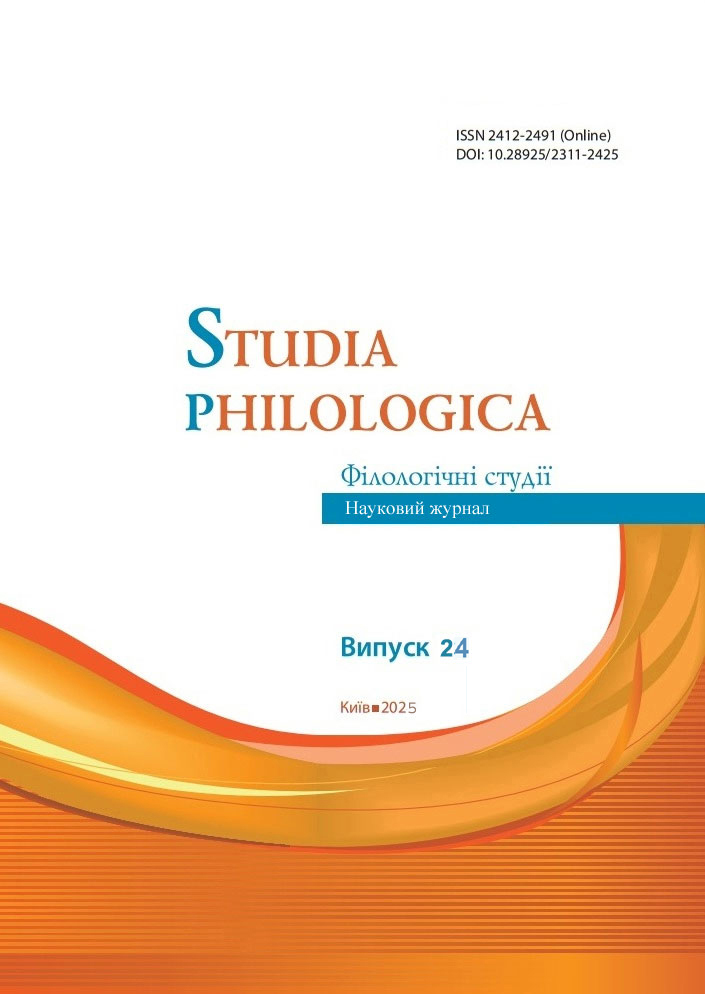International Legal English Discourse: its Notion and Main Peculiarities
DOI:
https://doi.org/10.28925/2311-2425.2025.243Keywords:
critical discourse analysis, international legal discourse, diplomatic discourse, legal discourse, loanwordsAbstract
This research reveals international legal discourse main peculiarities. The issue discussed includes international legal discourse distinction from related types of discourse – legal and diplomatic ones. International legal discourse was formed on the overlap of diplomatic and legal discourses. Thus, international legal discourse in English has such significant peculiarities as assimilation, institutionalization, prolixity, ambiguity, use of Latinisms and French loanwords, impersonalization, excessive solemnity and politeness, use of words associated with legal discourse including archaisms as well as legal terms, etc. Therefore, international legal discourse is an autonomous type of discourse that gradually changes and reveals perspectives for the future research.
Downloads
References
Azadbakht, F. (2019). The Language of International Law; Monologue or Polyphonic Test. International Studies Journal (ISJ), Vol. 15, No. 4 (60), 19-30. https://doi.org/10.22034/isj.2019.89543
Butko, N.G., & Butko, O.A. (2023). A Short Analysis of English Legal Discourse. The XXIV International Scientific and Practical Conference «Current scientific opinions on the development of current education», 208-209. https://eu-conf.com/events/current-scientific-opinions-on-the-development-of-current-education/
Butko O.A. (2023). The Pragmatics and the Discourse Interconnection. IІ International scientific and practical conference «Modern Approaches to Problem Solving in Science and Technology». Warsaw, Poland
https://isu-conference.com/arkhiv/modern-approaches-to-problem-solving-in-science-and-technology/
Cheng, L., & Machin, D. (2022). The law and critical discourse studies. Critical Discourse Studies, 20(3), 243 - 255. https://doi.org/10.1080/17405904.2022.2102520
Coaguila, J. (2005). El análisis discursivo del derecho. Isonomía, Revista de Teoría y Filosofía del Derecho, núm. 23, 165-177.
https://www.scielo.org.mx/scielo.php?script=sci_arttext&pid=S1405-02182005000200008
D’Acquisto, G. (2017). A Linguistic Analysis of Diplomatic Discourse: UN Resolutions on the Question of Palestine. Cambridge Scholars.
Dellavalle, S. (2017). Law as a Linguistic Instrument Without Truth Content? On the Epistemology of Koskenniemi’s Understanding of Law. Max-Planck-Institut für ausländisches öffentliches Recht und Völkerrecht, 199-233. https://doi.org/10.2139/ssrn.2773743
Domínguez, F.N. (1999). El discurso jurídico. Aspectos lingüísticos y culturales del lenguaje jurídico en los países del área francófona y su relación con la traducción. Lengua y cultura estudios en torno a la traducción : volumen II de las actas de los VII Encuentros Complutenses en torno a la traducción, 437-446.
https://cvc.cervantes.es/lengua/iulmyt/pdf/lengua_cultura/54_navarro.pdf
Goodrich, P. (1984). Legal Discourse; Studies in Linguistics, Rhetoric and Legal Analysis. University of Edinburgh.
Gotti, M. (2008). El discurso jurídico en diversas lenguas y culturas: Tendencia a la globalización e identidades locales. Revista Signos, 41(68) 381-401
https://www.redalyc.org/pdf/1570/157013774002.pdf
Goy, C.Q. (2022). La lingüística y el derecho. Un análisis desde a perspectiva de género. Revista Digital de Políticas Linguísticas, Núm. 16. https://revistas.unc.edu.ar/index.php/RDPL/article/view/39528
Hall, E.T., Hall M.R. (1990). Understanding Cultural Differences. Intercultural Press, Yarmouth, Maine.
Hofstede, G. (2001). Culture's Consequences: Comparing Values, Behaviors, Institutions and Organizations Across Nations. Sage.
Holtseva, M. (2023). Anglomovnyi dyplomatychnyi dyskurs Rady Bezpeky OON: struktura i pragmatyka [Dissertation for Ph.D. Degree in Philology, Borys Grinchenko Kyiv University] (in Ukrainian). https://elibrary.kubg.edu.ua/id/eprint/46099/
International Covenant on Civil and Political Rights (1966). https://www.ohchr.org/en/instruments-mechanisms/instruments/international-covenant-civil-and-political-rights
Kravchenko, N.K. (2007). Mizhnarodno-pravovyi dyskurs: kognityvno-komunikatyvnyi aspekt [Dissertation for Sc.D. Degree in Philology (10. 02. 15 - General linguistics), Taras Shevchenko National University of Kyiv] (in Ukrainian).
Kravchenko, N.K., & Nikolska, N.V. (2020). Discourse Structure Relationships (Based on International Legal “Soft Law” Discourse). International journal of philology, Vol. 11, № 1, 2020, 101-107. https://doi.org/10.31548/philolog2020.01.101
Kolesnyk, O. (2018). Verbal Representations of the Value-Concepts: A Linguo-Cultural Sketch. Linguaculture,. 9(1), 41–54. https://doi.org/10.47743/lincu-2018-1-0112
Kolesnyk, O.S., & Holtseva, M. (2022). Lies and deception in modern english diplomatic discourse: pragmatics in interdisciplinary focus. Cogito - Multidisciplinary research journal, 14 (1). pp. 154-173. https://cogito.ucdc.ro/COGITO_MARTIE_2022.pdf
Kopytina, A., & Makhachashvili, R.K. (2021). Associative conceptual constant of subconcepts E-space and Cyberspace. Periodyk naukowy akademii polonijnej (1). pp. 71-84. https://doi.org/10.23856/4408
Loma-Osorio Fontecha, M. (2004). Estructura y función del texto económico fundamentos de una léxico-gramática del discurso económico en español y en inglés. Madrid: Universidad Complutense de Madrid, PhD thesis.
https://www.europeana.eu/mt/item/9200101/BibliographicResource_1000126629852
Makhachashvili, R.K., & Bilyk, K. (2019). Korpusne doslidzhennia tekstiv rubryky “nadzvychaini novyny” u frantsuzkii, angliiskii ta ukraiinckii movah. Naukovyi visnyk Mizhnarodnoho humanitarnoho universytetu, Seria Filologia, 4 (43), 151-154.
https://doi.org/10.32841/2409-1154.2019.43.4.36
Makhachashvili, R.K., & Bilyk, K. (2021). Doslidzhennia funktsionalno-linhvistychnykh aspektiv zaholovkiv tekstiv novyn u suchasnomu frantsuzkomu mediadyskursi. Naukovyi visnyk Mizhnarodnoho humanitarnoho universytetu, Seria Filologia, 1 (48), 139-143. https://doi.org/10.32841/2409-1154.2021.48-1.33
Mowbray, J. (2014). “The future of international law: shaped by English”, Völkerrechtsblog, https://doi.org/10.17176/20170104-165855
Pozhar, A. (2021). “Movlennevi akty ekspresyviv u mizhnarodno-pravovomu
dyskursi: typy, struktura i funktsii”. Scientific journal of the Lviv State University of Life Safety “Philological Periodical of Lviv”, № 10, 2021. https://doi.org/10.32447/2663-340X-2021-10.17
Reservations and declarations made by State parties of the International Covenant on Civil and Political Rights (ICCPR). (2017).
https://ccprcentre.org/files/media/List_of_ICCPR_reservations.pdf
Scott, R. (2001). Institutions and Organizations. Sage.
Smolka, J., & Pirker, B. (2016). International Law and Pragmatics — An Account of Interpretation in International Law. International Journal of Language & Law vol. 5, 1-40. https://doi.org/10.14762/jll.2016.001
UNCTAD (2024). UN list of least developed countries https://unctad.org/topic/least-developed-countries/list
United Nations. (n.d.). New globalization report: Three mega-trends expected to impact our future. https://www.un.org/en/desa/new-globalization-report-three-mega-trends-expected-impact-our-future
United Nations. Peremptory norms of general international law (Jus cogens). Analytical Guide to the Work of the International Law Commission (2024).
https://legal.un.org/Ilc/guide/1_14.shtml
United Nations Charter (1945). https://untso.unmissions.org/sites/default/files/united_nations_charter.pdf
United Nations Convention on the Law of the Sea (1982). https://www.un.org/depts/los/convention_agreements/texts/unclos/unclos_e.pdf
van Leeuwen, T. (1996). The representation of social actors. In C.R. Caldas-
Coulthard & M. Coulthard (Ed.), Texts and Practices. Readings in Critical Discourse Analysis (pp.32-70). Routledge.
Vienna Convention on Diplomatic Relations (1961). https://legal.un.org/ilc/texts/instruments/english/conventions/9_1_1961.pdf
Vienna Convention on the Law of Treaties (1969). https://legal.un.org/ilc/texts/instruments/english/conventions/1_1_1969.pdf
Whittaker, S. (2014). Contrastive legal discourse research. Corpus design and applications. Revue française de linguistique appliquée, 2014 (1) (Vol. XIX), 49-57. https://www.cairn.info/revue-francaise-de-linguistique-appliquee-2014-1-page-49.htm?ref=doi
Zhang, J. (2015). Implicitness Constructed and Translated in Diplomatic Discourse. Newcastle upon Tyne: Cambridge Scholars Publishing.
Published
How to Cite
Issue
Section
License
Copyright (c) 2025 CC BY 4.0 DEED Attribution 4.0 International

This work is licensed under a Creative Commons Attribution 4.0 International License.


